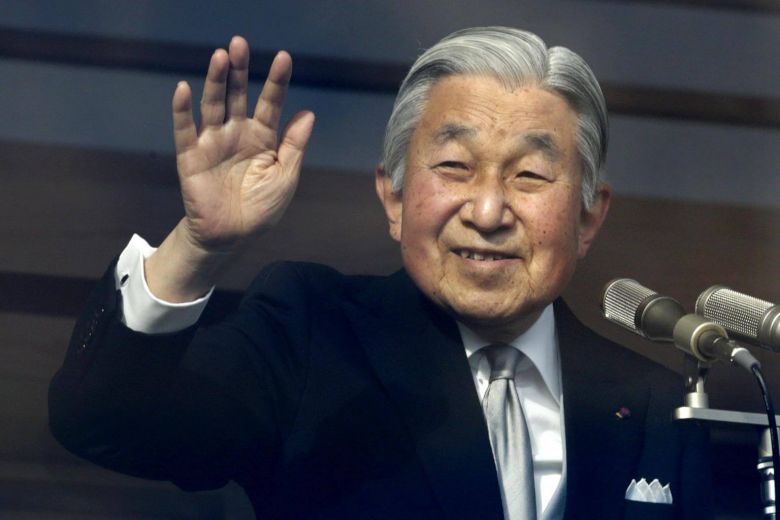Japanese Emperor Akihito to step down today in first abdication in two centuries

Emperor Akihito, 85, helped modernise the world's oldest hereditary monarchy.PHOTO: EPA-EFE
TOKYO, Apr 30, 2019, Bloomberg, AFP. Japanese Emperor Akihito will end his three-decade reign on Tuesday (April 30), voluntarily stepping down due to health concerns to make way for his son in the country’s first abdication of the Chrysanthemum Throne since 1817, reported The Straits Times.
His 31-year imperial era known as Heisei, which can be translated as “achieving peace”, was set to come to an end with a ceremony attended by about 300 political leaders and dignitaries starting at about 5pm local time at the Imperial Palace in Tokyo. The next morning, his son, Crown Prince Naruhito, 59, will ascend the throne in ceremonies also at the palace.
The ritual-bound process began on Tuesday morning with the emperor, dressed in expansive golden-brown robes and a towering black headpiece, “reporting” his abdication to his ancestors and the gods at several “sanctuaries” at the palace.
But the main event will be at precisely 5pm local time, when the 85-year-old will formally step down in a 10-minute ceremony in the “Matsu-no-Ma” (“Room of Pine”), considered the most elegant hall in the sumptuous Imperial Palace.
The ritual will be conducted in the presence of the imperial regalia – an ancient sword and jewel – considered crucial evidence of an emperor’s legitimacy.
However, Crown Prince Naruhito will not become emperor of Japan until the stroke of midnight and he will “inherit” the regalia at a second ceremony on Wednesday at 10.30am before making his first official public remarks shortly afterwards.
Wednesday’s ceremony was expected to be attended by just one woman – the sole female member of Prime Minister Shinzo Abe’s Cabinet. Female royals are prohibited from participating.
The ceremonies will all take place behind closed doors, but small crowds had gathered outside the Imperial Palace in Tokyo on Tuesday morning, despite clouds and rain.
“I’d like to thank the emperor for his hard work,” said 76-year-old Mr Hironari Uemara, visiting Tokyo from Okayama in western Japan.
His wife said she would miss Emperor Akihito and the outgoing imperial Heisei era. “I feel like crying,” she told AFP.
Emperor Akihito, 85, helped modernise the world’s oldest hereditary monarchy. He was the first Japanese emperor to marry a commoner – Empress Michiko – and the first to reign entirely under the US-drafted postwar, pacifist constitution that made the role strictly symbolic.
His unprecedented apologies for the wartime aggression launched in the name of his father, Hirohito – posthumously named the Emperor Showa – helped ease often fraught relations with neighbours China and South Korea, which bore heavy blows from Japan’s militarism. Emperor Akihito spoke in ordinary Japanese, rather than the formal grammar employed by his father, the last emperor regarded by prevailing custom to be a living deity.
His Heisei era started in 1989 when Japan was an economic juggernaut, its companies seemed unstoppable and its products flooded global markets. But the asset-inflated bubble economy came crashing down from 1991 and about 20 years after that, Japan’s once-impoverished neighbour China overtook it as the world’s second-largest economy.
Japan became the developed world’s fastest-ageing country during his reign and it managed disasters that included the 1995 earthquake that devastated the Kobe area and the 2011 earthquake and tsunami that hit the north-eastern coast, leaving about 20,000 people dead or missing. Emperor Akihito and his wife Michiko visited survivors at shelters and were seen by many in Japan as helping a battered nation recover through their compassion.
With public criticism of the emperor seen as a taboo and his public words often restricted to carefully prepared texts, Emperor Akihito has largely been shielded from scandal.
Japan has set aside some 16.6 billion yen (S$202 million) for months of ceremonies related to the change of emperor, the Nikkei newspaper reported in December, and extended its “Golden Week” spring holiday to 10 days. There has been a flood of TV programming taking sentimental journeys through the Heisei years, counting down its best songs and recapping its history.
The nattily dressed Akihito has spent the last few weeks of his reign touring the country with Empress Michiko, waving to crowds and performing rituals at shrines to symbolically inform his ancestors that he is stepping down. His health concerns included prostate surgery in 2003 and heart bypass surgery in 2012.
In 2016, Emperor Akihito told the public he may no longer be physically fit enough to carry out his duties. This set the stage for parliament to pass a one-time law about a year later allowing abdication, with a special panel then setting April 30, 2019, as the end of his imperial era. The last emperor to abdicate was Kokaku, who stepped down two centuries ago to make way for his son.
In retirement, Emperor Akihito will take the title “Emperor Emeritus” and move into a smaller imperial residence with Empress Michiko, whom he first met on a tennis court more than 60 years ago.
But there will be no parade, for now, to welcome the new emperor. That will come on Oct 22, which will also be a national holiday.